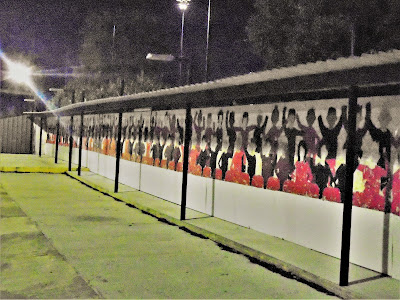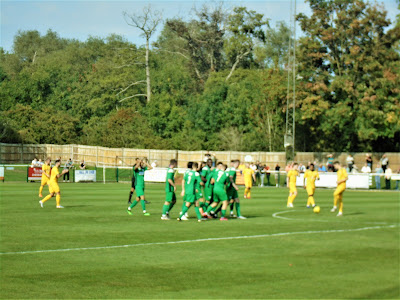
One thing I'm finding interesting about ground-hopping around various regional leagues is discovering these long, proud, parallel histories of non-League clubs, about which was I previously entirely ignorant. I really wanted to go to a match with my friend Chris, who I met in 2008 through our shared support of Norwich City and the campaign I co-founded against homophobia in football, who helped me to get my Guardian series ten years ago and has been with me to numerous Norwich games, as well as visiting me at Horley Town back in 2012. At this level, it's not too easy to pin down fixtures: I can't locate a centralised calendar, even on The Non-League Paper site, and my current solution is to trawl through a self-made Twitter list of south-eastern teams in the hope of finding something. This week there were plenty of Tuesday games, but Chris could only do Wednesday, and all I could see was an Essex Senior League tie at Ilford – a place and team I knew very little about, despite it being less than ten miles away from my east London home.
Indeed, I joked on Twitter that I '[didn't] know about Ilford chants', so I would just 'loudly recite the milk speech for the entire match' – a reference to the only thing I knew about the area, its former MP Mike Gapes, whose bizarre Commons outburst about milk, the Irish border and Brexit has become a left-wing meme, and who lost his seat in the recent election after forming the ill-conceived splitter party (or Kaufmanesque performance art project) Change UK. (It turns out that Gapes, a big West Ham fan, is one of Ilford FC's Vice-Presidents.) I walked through the town, seeing its Renaissance-style Town Hall and the Kenneth More Theatre, a stylish Brutalist building opened in January 1975 with a studio for experimental work that is sadly unlikely to survive lockdown (having been threatened with closure last July for financial reasons) and got to Cricklefield Stadium well ahead of kick-off, having no trouble buying a ticket despite worrying that this local derby against Redbridge might sell out, given the limited capacity.
I had no trouble getting in: there were none of the coronavirus-related delays I had at Balham, and in fact the fewest signs yet of the pandemic, despite the afternoon's announcement that gatherings of more than six people, indoor or outdoor, were once again to be outlawed due to a nationwide spike in the infection. It turned out this didn't apply to workplaces, schools or 'Covid-secure sports events', so I heard no anxieties about football shutting down again once the restrictions come in on Monday. (It does mean, however, that Norwich City have put their plans for a limited re-admittance of fans on hold.) On the door, Steve – the club's media man – recognised me from Twitter (as I'd tagged the club) and I said I wouldn't necessarily be leading the chants (although I decided against a detailed explanation of the Gapes memes), instead telling him about my "project" of visiting lots of non-League clubs this season and writing about it.

Steve encouraged me to dedicate myself to Ilford FC. Just four games into this nomadic season, I've already noticed how every team I visit wants me as a regular supporter, and I believe them more than I'd believe a bigger club using a hashtag like '#EveryFanMatters' on social media – mainly because it's so easy to have face-to-face conversations with the people running the operation. When I said I usually went to Norwich City, he told me that Ilford had got to the FA Cup first round (proper) in 1958-59 and gone out to Norwich, at the start of a run that ended with the Canaries becoming one of a handful of sides to reach the semi-final while in the third division. As at Horley Town, the chairman was on the turnstile, and I was soon talking to three people about how Ilford's history went back to 1881, having survived the mergers that have swallowed up many smaller east London sides, and they were considered important enough to play tour matches against Barcelona (and Ajax) in the 1920s. (The picture above is from a display at the bar – the club recently got a National Lottery grant to fix up the main stand and put on an exhibition about their past.) One of the group said he'd first heard of the club in 1974, when they reached the last-ever FA Amateur Cup final, walking out at Wembley in front of a crowd of 30,500. This had made him a lifelong fan, but Ilford have never made it back to the national stadium for the finals of either of the competitions that replaced the Amateur Cup, the FA Trophy and the FA Vase.
Could they reach such heights again, in terms of achievement or support? In the age of neoliberalism and globalisation, the two things have become detached at the highest levels, at least to some extent: for example, AFC Bournemouth, who had rarely been out of the bottom two divisions before 2010, were able to sustain Premier League football for five years despite having a capacity of less than 12,000 due to investment from Russian businessman Maxim Demin. With no international exposure or television money, Ilford are reliant on gate receipts, and need more than the occasional Non-League Day – usually held when the top two leagues are on an international break – to bring in enough to have a chance of reasserting themselves as one of England's leading non-League teams. Non-League Day has been cancelled this autumn due to the ongoing uncertainty, but every Saturday is non-League day right now, and there may never be a better time for Ilford to capture wandering fans.
Walking through the town, I wondered if more long-term socio-economic changes may benefit the club. There's talk of the pandemic bringing down rents in east London, but I haven't seen it, and as people move ever further from the centre, Ilford will probably gentrify, with its bus and fast train links to Stratford and Liverpool Street. Another famous old club, Dulwich Hamlet – who had players representing England as late as the 1920s – have climbed back up to the sixth tier as people moving to south-east England have adopted them and developed a vibrant fan culture, and the same could happen to Ilford over the next decade or so.

On tonight's evidence, new arrivals could do far worse than come to Cricklefield regularly. I didn't lead the chants, and nor did anyone else: with an athletics track putting fans at some distance from the pitch, and no stands behind the goals, it doesn't lend itself so well to the passionate fan cultures of Clapton CFC or Dulwich Hamlet, or even Walthamstow. But it feels like an appropriate home for a famous old club, with banners around sporting photos of Ilford's FA Amateur Cup Final appearance in 1958, and the packed main stand where most of us congregated saw Ilford race into a 3-0 lead within twenty minutes, the pick of the goals being a great free-kick by their right winger, Juan Cardona, that would have graced any occasion.Redbridge won and scored a penalty just before half-time, and after the interval, pushed for another goal to bring them back into contention. Ilford's new goalkeeper, Josh Blackburn, made several astonishing saves, and then Cardona hit Redbridge on the break to complete his hat-trick. Yemi Adelani struck his second of the night to put Ilford 5-1 up; Chris and I were just talking about how Redbridge's striker Josh Sykes, on a substitute, was looking useful when he was sent off for elbowing a home defender as he went for a high ball. Sykes walked down the athletic track towards the changing room saying "I might as well become a fucking ballerina", adding the words "bald cunt" to further amuse the fans, with whom he soon came and sat. There was one more goal for each team and the amassed supporters clapped and cheered Ilford off at the end – if they are going to attract the kind of crowds that they did in the age before many domestic league matches were televised, and rise back up the leagues or through the rounds of the cup competitions, this felt like the perfect way to start.













